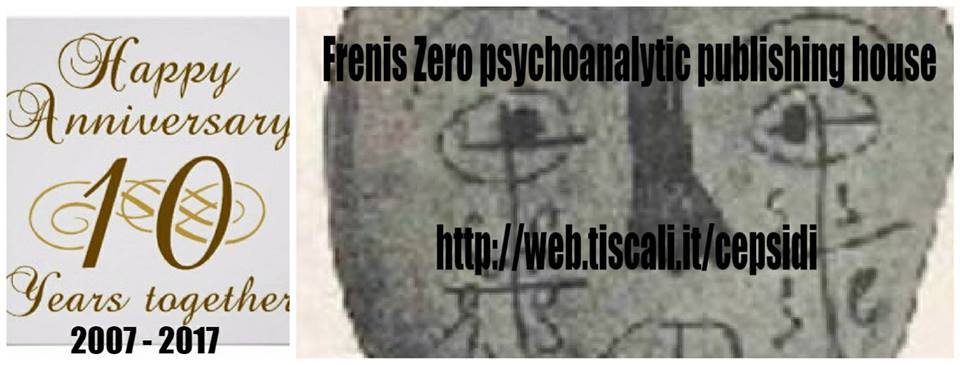|
In this
last number of our journal we published some papers sharing one common
concern: in a situation in which psychoanalysis risks to suffer for a
relative isolation from other psychotherapeutic approach and
<<methodological links to biology, psychology and psychiatry,
and, above all, lacking in sufficient empirical research to support
the efficacy of psychoanalytic treatment>> (J. P. Jimenez, 2012,
in "Psychoanalysis and its Borders, edited by G. Leo, p.127), we
have to spread a psychoanalytic literature not solely based on
hermeneutic principles, but open to confining fields of science (neuroscience,
Infant Research, etc.) in order to strengthen "the evidence base
of psychoanalysis" in accordance with which psychoanalysis
<<should (...) develop
closer links with alternative data gathering methods available in
modern social and biological science>> (Fonagy
et al., 1999, in Fonagy, Kaechele, Krause, Jones, Perron, "An
open door review of outcome studies in psychoanalysis: Report prepared
by the Research Committee of the IPA at the request of the President,
University College, London, p.45).
Christian
Roesler in his article "Development
of Research Designs for Investigating Concepts of Analytical
Psychology and the Efficacy/Effectiveness of Jungian Psychotherapy"
maintains that what emerges in many outcome studies
<< it is not the method which is crucial for outcome in
psychotherapy, but the person of the therapist and how he/she succeeds
in creating positive expectations in the client as well as in handling
the therapeutic relationship. Especially the capacity of the therapist
to adapt in a flexible way to the special needs of the client as well
as to their changes over the course of therapy seems to be a crucial
factor.>> (Roesler, ibidem). This implies that emphasizing
manualized approaches, like the ones promoted by CBT, does not make
really sense. It is important that candidated could be well trained
in order to become competent psychotherapists: this is a pre-requisite
for any outcome psychotherapy project and study.
Jakub
Przybyla in the paper "Philosophical
and methodological problems concerning neuropsychoanalysis" criticizes
the idea of integrating neurobiology and psychotherapy based mainly on
the study of psychoanalysis and neuropsychoanalysis. The author
focuses on the philosophical and methodological problems which arise
from attempts to carry out this integration. The article presents
the view that this approach is a harmful reduction. It also proposes a
look at the relationship between psychotherapy and neurobiology as an
area of
cooperation
that avoids the confusion of theoretical languages.
Concerning
neuroscientific understanding of memory processes, particularly in
post-traumatic dissociative disorders, is the paper by Jelena
Radulovic, Royce Lee and Andrew Ortony "State-Dependent
Memory: Neurobiological Advances and Prospects for Translation to
Dissociative Amnesia". The authors try to answer to the
question of why memory for some traumatic experiences is compromised
whereas other comparably traumatic experiences are remembered well.
They introduce in their article clinical, cognitive, and
neurobiological perspectives on memory research, in particular
examining the role of state-dependent memory and discuss how advances
in neurobiology of this kind of memory, gleaned from animal studies,
might be translated to humans.
Closer
to a clinical perspective are the papers by Beate Schumacher "'We
are all born naked'- is the rest drag? Some thoughts on gender
identity development and psychoanalysis", and by
Pilios-Dimitris Stavrou "The
Consequences of Childhood Sexual Abuse on the Conjugal Life of a Young
Woman and the Effects of the Psychoanalytic Psychotherapy as a
Method of Treatment".
Finally,
Michael Forrester's article "Psychoanalytic
Underpinnings of Socially-Shared Normativity" considers the
proposal that psychoanalytic thinking might inform our understanding
of how socially shared normativity emerges during infancy and early
childhood. First,
a framework is sketched out that highlights the fact that from the
beginning, an infant’s earliest experience is bound up with those
procedures, practices, and social actions that make up what
conversation analysts call members’ methods. Second, comparisons are
drawn between conversation analysis and psychoanalytic accounts of
early experience for infants during the first years of life.
Discussion then moves to the Kleinian notion of object relations and
the concept of projective identification. Essentially, this is a
theoretical account of how “what-was-once-one” (the mother-infant
unit) somehow differentiates resulting in the gradual emergence of the
“individuated being.” What is often glossed over in this account
is the discursively embedded nature of projective identification; a
process that is itself interdependent with the embodiment that makes
up the infant’s lived engagement with the world. Whatever might
constitute consciousness emerges from somatic, embodied,
material-physical, tactile/affective experience – that is, a
fundamentally social milieu. Ultimately, this raises the question of
how transformation (i.e., from the social to the individual) occurs.
One answer may be Winnicott’s idea of the transitional space, where
the “good-enough” parent is said to be somebody, who can
“contain” both negative and positive identifications coming from
the infant, transform and re-project such identifications, but in
modified form. In this way, the infant begins to recognize/experience
what it is they are “feeling.” Such projective identifications are
conveyed within and through the prevailing discourses that constitute
all social practices. Concluding comments note that conversation
analysis may find in psychoanalytic thinking a framework for
understanding the interdependence between affect and action, given
that in psychoanalytic thought, we find a thoroughly relational
conception of human nature.
|





